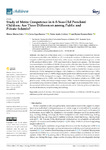Study of Motor Competence in 4–5-Year-Old Preschool Children: Are There Differences among Public and Private Schools?

Use este enlace para citar
http://hdl.handle.net/2183/27944
A non ser que se indique outra cousa, a licenza do ítem descríbese como Atribución 4.0 International (CC BY 4.0)
Coleccións
- Investigación (FEDU) [938]
Metadatos
Mostrar o rexistro completo do ítemTítulo
Study of Motor Competence in 4–5-Year-Old Preschool Children: Are There Differences among Public and Private Schools?Data
2021Cita bibliográfica
Mecías-Calvo, M.; Lago-Fuentes, C.; Arufe-Giráldez, V.; Navarro-Patón, R. Study of Motor Competence in 4–5-Year-Old Preschool Children: Are There Differences among Public and Private Schools? Children 2021, 8, 340. https://doi.org/10.3390/children8050340
Resumo
[Abstract] The objectives of this study were (1) to investigate the presence of preschool children with severe motor difficulties (SMDs) and (2) to evaluate the existence of differences in the motor competence (MC) of preschool children from public and private schools based on gender. A total of 581 preschool children (4.66 ± 0.52 years) from Galicia (Spain) were assessed. The Movement Assessment Battery for Children-2 (MABC-2) was used to collect the data. Preschool children from public schools presented a greater number of SMDs (OR = 20.65; CI = 9.99–85.53; p < 0.001). Preschool children from private schools have higher scores on the variables studied (for example, manual dexterity (p < 0.001), aiming and catching (p < 0.001), balance (p < 0.001), total test score (p < 0.001), and total percentage score (p < 0.001)). Regarding the gender factor, differences were found in manual dexterity (p < 0.001), aiming and catching (p = 0.014), balance (p < 0.001), total test score (p < 0.001), total percentage score (p < 0.001), and in the interaction of both factors in balance (p < 0.001), total global score (p = 0.004), and total percentage score (p < 0.001). Preschool children from private schools are less likely to have severe movement problems and score higher on all dimensions of the MABC-2 than preschool children from public schools analyzed in this study. Likewise, girls score higher than boys in all dimensions, except in aiming and catching.
Palabras chave
Preschool children
Movement Assessment Battery for Children-2 (MABC-2)
Gender differences
Public school
Private school
Movement Assessment Battery for Children-2 (MABC-2)
Gender differences
Public school
Private school
Versión do editor
Dereitos
Atribución 4.0 International (CC BY 4.0)






